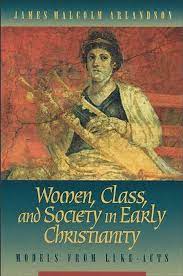
Women, class, and society in early Christianity : Models from Luke-Acts / James Malcolm Arlandson.
Tác giả chính:
Nguyên tác/ Nhan đề song song:
Thông tin xuất bản:
Peabody, Mass.:
Hendrickson, 1997
ISBN:
1565631811
Ký hiệu xếp giá / Cutter:
226.46 / AR-J
Tập:
Mô tả vật lý:
238 tr. ; 24 cm
Chủ đề:
Minh hoạ/ TL Kèm:
Tùng Thư:
Phụ chú:
Số lượng hiện có:
2/2
Nơi lưu trữ:
Kho Tổng hợp
Tóm tắt:
TABLE OF CONTENTS
ACKNOWLEDGMENTS ix
ABBRVIATIONS xi
LIST OF FIGURES xvii
CHAPTER 1: INTRODUCTION 1
CHAPTER 2: WOMEN AND CLASS IN THE ROMAN RMPIRE, I 14
A Macrosocial Model for Social Class 16
Governing Classes and Urban Elite 24
Retainers and Religionists 45
Rural People 52
CHAPTER 3: WOMEN AND CLASS IN THE ROMAN EMPIRE, II 67
Urban People 67
Landowners 68
Merchants and Traders 73
Artisans 82
Day Laborers 92
Slaves 98
The Unclean and Defraded 102
The Expendables 108
Men and Women in Luke-Acts 112
Conclusion 116
CHAPTER 4: WOMEN AND CLASS IN LUKE-ACTS 120
Women and the Kingdom of God 120
Women and Stratification in Luke-Acts 123
Summary 148
CHAPTER 5: THE FALL OF MEN AND THE RISE OF WOMEN 151
The Characterization Graph 153
Shame, Class, and Gender 155
Commentary 157
The Sinful Woman and Simon the Pharisee, 158
Luke 7:36-50
Mary Magdalene and the Twelve, Luke 8:1-3 162
23:55-24:10
A Daughter of Abraham and the Synagogue Ruler 168
Luke 13:10-17
The Poor-Generous Widow and the Rich, Luke 21:1-4 172
Samaritan Women and Simon, Acts 8:5-25 176
Persecuted Women and Saul, Acts 8:1-4; 9:1-22 181
Summary 184
CHAPTER 6: CONCLUSION 186
APPENDIX 195
Category 1 195
Category 2 196
Category 4 198
BIBLIOGRAPHY 201
INDEX OF MODERN AUTHORS 231
INDEX OF ANCIENT SOURCES 233
Especially given the burgeoning interest in the social world of the New Testament, it is remarkable that far too often scholars and students of the New Testament continue to view women homogeneously, as if all women in antiquity existed at the same social, political, and economic level.
Rather, women in antiquity, just as women of today, can be found anywhere along the spectrum of society, from voiceless slave to wealthy landowner. Failing to look at women's lives in light of their place in ancient class structures results in tunnelvision, and women are mistakenly depicted as being uniformly cut from the same social, economic, and political cloth.
Such misperception results in misunderstanding. First it perpetuates the notion that all women in antiquity were oppressed. Second it tends to neglect the under-classes.
Anyone interested in women's studies will find this work indispensable for understanding the variegated nature of women in the ancient world and the gospel's impact upon them.


